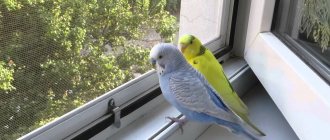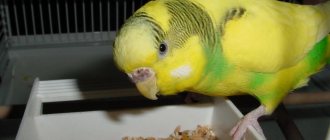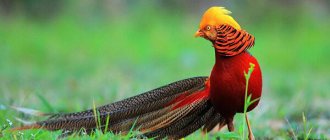We are used to the fact that a small part of pets can understand their owners. This also applies to birds. Most breeders prefer to keep budgies - as they are the smallest and most undemanding birds. They cannot learn a large number of words like Grays and cannot speak coherently. However, a set of certain signals and sounds allows them not only to communicate with each other, but also to contact the owner. In the article we will look at the main signals, what they mean and learn to understand the language of budgerigars.
Review of Computer Methods for Android
1. “Phrasebook for parrots.” For free. You can download it here.
The program is distributed free of charge. There are several levels of difficulty. List of words to remember: Hello. Birdie. Wonderful person. Hen. I love. Guard. Be healthy. I love you.
The program automatically repeats the word every few seconds. It is best to use the program in half-hour sessions to obtain effective results.
2. “Conversational genre for parrots.” Paid. You can download it here.
You can use the program to teach birds words, phrases, and various sounds. You can install and use the program on a desktop computer or laptop. Along with the program, you acquire a basic set of words and phrases that are best suited for first training. It is best to use the program periodically, several times a day for 5-8 minutes.
3. "Training Cockatiel." Free. In English.
Do you want your parrot to learn to say your favorite phrase? The program provides the opportunity to record and use custom sounds recorded through the voice recorder application during training.
4. “Dictaphone.” For free. You can download it here.
There is nothing easier than recording or speaking words into a voice recorder or recording phrases into mp3, which the bird will teach instead of you. One of the disadvantages is the lack of communication with the bird, but trust is an important component of successful training!
5. Methods that can be found on YouTube. For example, watch a video on how to teach a parrot to talk. You can simply play this video for your pet when you leave home:
Amazons are good communicators
The Amazon family includes several species that are gifted talkers. Amazons are easily identified by their predominantly green plumage with color variations of red, yellow, blue and orange on their heads, wings and tails.
The most talking parrots of this family:
Yellow-necked Amazon. The ability to reproduce speech manifests itself even faster than the bird’s quarrelsome nature. They can begin to speak like children and can learn hundreds of words. If you want a bird that talks and are willing to deal with its demanding personality, then this is the parrot for you.
Amazon with a yellow crown. Yellowcrowns are excellent talkers, but may not be as proficient with words as yellownecked Amazons.
White-fronted Amazon. Also valued for its ability to speak. It is friendly, hardy, easily tamed and amenable to training.
Venerable age
Another fairly common reason why a parrot does not chirp and is quiet is its advanced age. At poultry markets, there are often cases when elderly birds are sold to gullible buyers, passing them off as chicks. In such cases, silence is completely justified: birds whose age has reached 9–10 years behave much less active compared to young individuals.
At this age, the budgie does not chirp and is difficult to teach and train. Surveys of admirers of this species have shown that in old age it is practically impossible to teach such a bird to speak. The maximum that can be achieved is to imitate the sounds surrounding your pet (for example, the creaking of a door or the meowing of a cat).
Not tweeting because he's sick
The most alarming reason for a pet’s silence may be the initial signs of the disease. A reason for concern may be the sudden silence of the parrot, accompanied by other symptoms of an unhealthy condition, including:
Loss of appetite and lack of attention to offered treats;
- sleepy state - the bird moves little and constantly sits with a ruffled look;
- apathy, retardation of movements;
- cough or sneezing;
- indigestion, including loose stools;
- discharge from the beak, itching;
- indifference to external stimuli;
- discoloration, increased loss of feathers.
What to do
When the parrot stops chirping, there is definitely no reason to panic. Many of the factors listed in this article can be eliminated or corrected through increased attention to the pet or improved living conditions. A little effort, and your bird will once again delight your ears with its vibrant chirping.
However, in some cases you will have to come to terms with the fact that your pet, due to age or gender reasons, will not be as talkative as before. In such a situation, you just need to accept the parrot as it is and surround it with care and warmth. If you initially want a more social individual, then you should think about choosing a male.
If, over a long period of time, no measures taken restore the feathered friend’s former talkativeness, then it is worth thinking about the medical indications of the manifested syndrome and contact a veterinarian or ornithologist for an examination.
Features of the mating season
Before birds mate, a person can observe the mating season, during which the male persistently courts the girl.
The male performs the following actions:
- cleans the female's feathers;
- feeds the girl from his beak;
- regularly sings and dances around the couple;
- shows off in front of the female in different ways, for example, raising its crest and spreading its wings.
If a girl reacts favorably to such methods of courtship, then she will independently show signs of attention, for example, sitting down and caressing the male. Only after this does direct mating begin.
Did your parrots have chicks?
Not really
Why do budgies like to sing and dance?
Watching budgies sing or dance is a lot of fun. In addition, such dances delight not only people, but also the most feathered animals.
- Innate data. Birds have been shown to have an innate sense of rhythm. Therefore, after listening to a piece of music, parrots often jump into a dance or begin to sing out loud to the rhythm of the melody. The bird really likes such entertainment, and also delights people watching this spectacle. But it happens that the bird is not a music lover by nature and one should not be surprised when it does not react to the melodic sounds of a song.
- Imitation. Ornithologists say that in addition to an innate love of music, parrots also have good mimicry skills. After all, dancing skills are usually manifested precisely in those birds that have lived in captivity for a long time and observed the behavior of people. Birds see how people react to music (singing, dancing) and then try to copy this behavior.
When training dogs, the reward method is used: for every trick they perform, they receive a reward. But budgerigars sing and dance just like that, depending on their mood, and they don’t charge extra for demonstration performances.
Parrot dancing video
What kind of music do budgies like to listen to?
Budgerigars do not have any special musical preferences. For them, the main thing is a sense of rhythm in music. Indeed, there are people who prefer classics, and some even rock, but this has more to do with the preferences of their owners. What the bird hears most often, what it gets used to most, what it likes most.
Budgerigars perceive dance tunes best in words. And compositions without words make them despondent, indignant, and in response they scream loudly with disapproval.
Melodies for developing speech skills
Experts advise budgies to always play music. After all, this, in addition to developing gaming skills, stimulates conversation. Regular listening to music has been proven to speed up the process of learning human language. To benefit from listening to music and teaching your pet to talk, you must follow these rules:
- Set a regular time to listen to music (ideally in the morning before breastfeeding).
- Play the same part of the song every day.
- It is imperative to take into account the choice of the parrot (if the chick does not like the composition, he will ignore it and will not recognize it).
- Create a calm atmosphere in your home, get rid of all irritants.
- Don't shout, don't get angry, don't raise your voice with the bird.
- Hold the chicken in your hand.
- Praise the parrot even with small blows (if desired, give him a treat).
Budgerigars are very intelligent pets. By following the above guidelines, you can learn very quickly from the birds and listen to the first sentences.
Parrot Richie video. Speak and sing.
Video “Budgerigars Singing”
In this video you will hear budgerigars sing.
Sorry, there are no surveys available at this time.
Was this article helpful?
Thank you for your opinion!
The article was useful. Please share the information with your friends.
Yes (100.00%)
No
X
Please write what is wrong and leave recommendations on the article
Cancel reply
Rate the benefit of the article: Rate the author ( 3 votes, average: 3.67 out of 5)
Discuss the article:
Laying eggs
The laying of eggs is preceded by a change in the behavior of the female. She begins to often climb into the house, spend a lot of time in it, and throw out sawdust. The timing of the appearance of the first egg is individual, since each bird develops differently. As a rule, it can take from 1 to 4 weeks from hanging the house to laying it.
Before the eggs hatch, the male spends time at the entrance, sings songs and feeds the female. This is the first sign of the imminent appearance of eggs. Also, the upcoming clutch is indicated by the female’s increased eating of chalk, increased appetite, plucking of feathers on the belly and chest, a large amount of droppings, twitching of the bird’s tail and a noticeably enlarged belly.
Talk to Gray
“African gray parrots have a reputation for being smart and not loud,” Matti Sue Athan, a parrot behavior consultant for the International Association of Animal Behavior Consultants (IAABC), and author of “The Behaved Parrot,” said in an interview.
Atan reported that independent development of playing skills also affects the development of the bird’s vocal abilities. Special toys for birds, intensive training, which the bird masters in the period between the appearance of plumage and the onset of puberty, is the key to a well-mannered parrot with good vocal and conversational abilities. If the Gray is deprived of privileges with toys, then this may later affect his behavior - excessive loudness and destructive behavior in general.
On video: talking gray parrot
The owner of a gray gray cat named Rocket was amazed by his ability to learn new words every week, and now she knows exactly which parrots speak best. She said that he is prone to self-learning: “One day Rocket spied on me while eating food, and suddenly said: “I want some...”. I told him: “Rocket, go eat your grain.” He continued to insist: “I want some...”. Then he started doing what I call a somersault. It went up the front of the cage to the top, and down the back wall. He saw that his trick still didn’t work (and it was thanks to her that he always got what he wanted before). And when I again repeated that he should go eat his bird food, he said: “I want food... Please!” I was amazed at his persistence, and besides, he had never used the word “Please” before. Of course, Rocket will get his share of goodies."
Another owner of a Gray Gray, who currently has a vocabulary of 300 words, said that when the bird was brought from a pet store at the age of 4 months, she immediately greeted the owner with the word: “Hello.” The parrot said hello every time he saw a person. And a little later, he often mixed different words with the name of the mistress, teased her and laughed. “He knew he was joking and entertaining me. It was great,” says the owner. “He also learned several songs, and if you start singing the first verse, he will definitely sing along with the second.”
How do these birds sing?
It is not completely known why males perform more often than females. The female, of course, also sings, but less often. If you hear the cheerful loud performance of a male, whether he is alone or in company, it means that he is healthy and also full of joy and energy. In video and audio recordings you can fully immerse yourself in this symphony.
If you haven’t yet figured out why your lonely parrot trills in front of some objects, then know that it’s time to look for a mate. If the male is not alone in the cage, then with such glorious singing he can flirt and attract the attention of females. There is a more gentle, quiet version, which can often be heard when a partner feeds his girlfriend. She, too, can respond with the same gentle, quiet singing when she is satisfied with his advances.
Loneliness
In cases where your pet is usually healthy and cheerful, but suddenly becomes depressed, it is worth considering whether the bird is receiving enough attention. Often a budgie or cockatiel is silent because it lacks communication. It's all because of simple loneliness!
By nature, parrots are very sociable creatures. They live in flocks whose size can exceed several hundred individuals. This means that in their natural habitat, parrots are never left alone. That is why these birds constantly need to be around people or their own kind, otherwise they will simply get bored, which will negatively affect their health and general condition.
Don't underestimate the negative impact of loneliness on your parrot's well-being. Experts note that a severe form of depression can cause self-plucking syndrome, to which grays and cockatoos are most susceptible. If the processes that have begun are not stopped in time, the disease can lead to death.
In order to provide your pet with a comfortable existence, you can diversify its house with toys and various devices for relaxation and learning. It would also be a great idea to purchase a couple of pets at once! Many bird owners confirm that keeping several individuals of the same species in one cage at once significantly improves the life of the birds, and also contributes to their learning and development!











